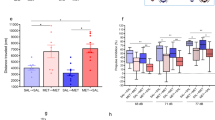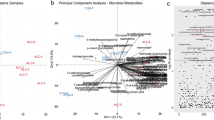Abstract
Schizophrenia is a kind of neurodevelopmental disease. Epidemiological data associates schizophrenia with prenatal exposure to famine. Relevant prenatal protein deprivation (PPD) rodent models support this result by observing decreasing prepulse inhibition, altered hippocampal morphology and impaired memory in offspring. All these abnormalities are highly consistent with the pathophysiology of schizophrenia. We developed a prenatal famine rat model by restricting daily diet of the pregnant rat to 50% of low protein diet. A metabolomics study of prefrontal cortex was performed to integrate GC-TOFMS and UPLC-QTOFMS. Thirteen controls and thirteen famine offspring were used to differentiate in PLS-DA (partial least squares-discriminate analysis) model. Furthermore, metabolic pathways and diseases were enriched via KEGG and HMDB databases, respectively. A total of 67 important metabolites were screened out according to the multivariate analysis. Schizophrenia was the most statistical significant disease (P = 0.0016) in our famine model. These metabolites were enriched in key metabolic pathways related to energy metabolism and glutamate metabolism. Based on these important metabolites, further discussion speculated famine group was characterized by higher level of oxidized damage compared to control group. We proposed that oxidative stress might be the pathogenesis of prenatal undernutrition which is induced schizophrenia.


Similar content being viewed by others
References
Akbarian S, Kim JJ, Potkin SG, Hetrick WP, Bunney WE Jr, Jones EG (1996) Maldistribution of interstitial neurons in prefrontal white matter of the brains of schizophrenic patients. Arch Gen Psychiatry 53:425–436
Belanger M, Allaman I, Magistretti PJ (2011) Brain energy metabolism: focus on astrocyte-neuron metabolic cooperation. Cell Metab 14:724–738. https://doi.org/10.1016/j.cmet.2011.08.016
Brown AS (2006) Prenatal infection as a risk factor for schizophrenia. Schizophr Bull 32:200–202. https://doi.org/10.1093/schbul/sbj052
Cannon M, Jones PB, Murray RM (2002) Obstetric complications and schizophrenia: historical and meta-analytic review. Am J Psychiatry 159:1080–1092. https://doi.org/10.1176/appi.ajp.159.7.1080
Chen JC, Turiak G, Galler J, Volicer L (1997) Postnatal changes of brain monoamine levels in prenatally malnourished and control rats. Int J Dev Neurosci 15:257–263
Daikhin Y, Yudkoff M (2000) Compartmentation of brain glutamate metabolism in neurons and glia. J Nutr 130:1026S–1031S
Figley CR (2011) Lactate transport and metabolism in the human brain: implications for the astrocyte-neuron lactate shuttle hypothesis. J Neurosci 31:4768–4770. https://doi.org/10.1523/JNEUROSCI.6612-10.2011
Hales CN, Barker DJ (2001) The thrifty phenotype hypothesis. Br Med Bull 60:5–20
Hulshoff Pol HE, Hoek HW, Susser E, Brown AS, Dingemans A, Schnack HG, van Haren NEM, Pereira Ramos LM, Gispen-de Wied CC, Kahn RS (2000) Prenatal exposure to famine and brain morphology in schizophrenia. Am J Psychiatry 157:1170–1172. https://doi.org/10.1176/appi.ajp.157.7.1170
Itoh Y, Esaki T, Shimoji K, Cook M, Law MJ, Kaufman E, Sokoloff L (2003) Dichloroacetate effects on glucose and lactate oxidation by neurons and astroglia in vitro and on glucose utilization by brain in vivo. Proc Natl Acad Sci U S A 100:4879–4884. https://doi.org/10.1073/pnas.0831078100
Kasischke KA, Vishwasrao HD, Fisher PJ, Zipfel WR, Webb WW (2004) Neural activity triggers neuronal oxidative metabolism followed by astrocytic glycolysis. Science 305:99–103. https://doi.org/10.1126/science.1096485
Lopez-Ibanez J, Pazos F, Chagoyen M (2016) MBROLE 2.0-functional enrichment of chemical compounds. Nucleic Acids Res 44:W201–W204. https://doi.org/10.1093/nar/gkw253
McGrath J, Saari K, Hakko H, Jokelainen J, Jones P, Järvelin MR, Chant D, Isohanni M (2004) Vitamin D supplementation during the first year of life and risk of schizophrenia: a Finnish birth cohort study. Schizophr Res 67:237–245. https://doi.org/10.1016/j.schres.2003.08.005
Morgane PJ, Mokler DJ, Galler JR (2002) Effects of prenatal protein malnutrition on the hippocampal formation. Neurosci Biobehav Rev 26:471–483
Ng F, Berk M, Dean O, Bush AI (2008) Oxidative stress in psychiatric disorders: evidence base and therapeutic implications. Int J Neuropsychopharmacol 11:851–876. https://doi.org/10.1017/S1461145707008401
Palmer AA, Printz DJ, Butler PD, Dulawa SC, Printz MP (2004) Prenatal protein deprivation in rats induces changes in prepulse inhibition and NMDA receptor binding. Brain Res 996:193–201
Prabakaran S, Swatton JE, Ryan MM, Huffaker SJ, Huang JTJ, Griffin JL, Wayland M, Freeman T, Dudbridge F, Lilley KS, Karp NA, Hester S, Tkachev D, Mimmack ML, Yolken RH, Webster MJ, Torrey EF, Bahn S (2004) Mitochondrial dysfunction in schizophrenia: evidence for compromised brain metabolism and oxidative stress. Mol Psychiatry 9:684–697. https://doi.org/10.1038/sj.mp.4001511
Rapoport JL, Addington AM, Frangou S, Psych MR (2005) The neurodevelopmental model of schizophrenia: update 2005. Mol Psychiatry 10:434–449. https://doi.org/10.1038/sj.mp.4001642
Saransaari P, Oja SS (2000) Taurine and neural cell damage. Amino Acids 19:509–526
Schousboe A, Scafidi S, Bak LK, Waagepetersen HS, McKenna MC (2014) Glutamate metabolism in the brain focusing on astrocytes. Adv Neurobiol 11:13–30. https://doi.org/10.1007/978-3-319-08894-5_2
Shen Q, Li ZQ, Sun Y, Wang T, Wan CL, Li XW, Zhao XZ, Feng GY, Li S, St Clair D, He L, Yu L (2008) The role of pro-inflammatory factors in mediating the effects on the fetus of prenatal undernutrition: implications for schizophrenia. Schizophr Res 99:48–55. https://doi.org/10.1016/j.schres.2007.10.010
Spratlin JL, Serkova NJ, Eckhardt SG (2009) Clinical applications of metabolomics in oncology: a review. Clin Cancer Res 15:431–440. https://doi.org/10.1158/1078-0432.CCR-08-1059
St Clair D et al (2005) Rates of adult schizophrenia following prenatal exposure to the Chinese famine of 1959-1961. JAMA 294:557–562. https://doi.org/10.1001/jama.294.5.557
Susser E, Neugebauer R, Hoek HW, Brown AS, Lin S, Labovitz D, Gorman JM (1996) Schizophrenia after prenatal famine. Further evidence. Arch Gen Psychiatry 53:25–31
Tonkiss J, Galler JR (1990) Prenatal protein malnutrition and working memory performance in adult rats. Behav Brain Res 40:95–107
Tonkiss J, Galler JR, Formica RN, Shukitt-Hale B, Timm RR (1990) Fetal protein malnutrition impairs acquisition of a DRL task in adult rats. Physiol Behav 48:73–77
Vagnozzi R, Tavazzi B, Signoretti S, Amorini AM, Belli A, Cimatti M, Delfini R, di Pietro V, Finocchiaro A, Lazzarino G (2007) Temporal window of metabolic brain vulnerability to concussions: mitochondrial-related impairment--part I. Neurosurgery 61:379–388; discussion 388-379. https://doi.org/10.1227/01.NEU.0000280002.41696.D8
van Elst LT et al (2005) Increased prefrontal and hippocampal glutamate concentration in schizophrenia: evidence from a magnetic resonance spectroscopy study. Biol Psychiatry 58:724–730. https://doi.org/10.1016/j.biopsych.2005.04.041
van Os J, Selten JP (1998) Prenatal exposure to maternal stress and subsequent schizophrenia - the may 1940 invasion of the Netherlands brit. J Psychiatry 172:324–326. https://doi.org/10.1192/bjp.172.4.324
Xu MQ, Sun WS, Liu BX, Feng GY, Yu L, Yang L, He G, Sham P, Susser E, St. Clair D, He L (2009) Prenatal malnutrition and adult schizophrenia: further evidence from the 1959-1961 Chinese famine. Schizophr Bull 35:568–576. https://doi.org/10.1093/schbul/sbn168
Xu J, He G, Zhu J, Zhou X, St Clair D, Wang T, Xiang Y, Zhao Q, Xing Q, Liu Y, Wang L, Li Q, He L, Zhao X (2014) Prenatal nutritional deficiency reprogrammed postnatal gene expression in mammal brains: implications for schizophrenia. Int J Neuropsychopharmacol 18. https://doi.org/10.1093/ijnp/pyu054
Yao JK, Reddy R (2011) Oxidative stress in schizophrenia: pathogenetic and therapeutic implications. Antioxid Redox Signal 15:1999–2002. https://doi.org/10.1089/ars.2010.3646
Acknowledgements
We appreciate the contribution of the members participating in this study. This work was supported by the National Key Research and Development Program (2016YFC0906400, 2016YFC1306700, 2016YFC0905000), the National Nature Science Foundation of China (81421061, 81361120389, 814018238), and the Shanghai Key Laboratory of Psychotic Disorders (13dz2260500).
Author information
Authors and Affiliations
Contributions
HG and ZXZ conceptualized this experiment. LX analyzed data and provided ideas for this manuscript. XF wrote this paper. Others participated in the course of rats feeding.
Corresponding authors
Ethics declarations
All the experimental procedures and protocols were complied with the National Institute of Health Guide for the Care and Use of Laboratory Animals and approved by the Institutional Animal Care and Use Committee at Experimental Animal Center in Shanghai Jiao Tong University.
Conflict of interest
All authors have no conflicts of interest in this work.
Additional information
Publisher’s note
Springer Nature remains neutral with regard to jurisdictional claims in published maps and institutional affiliations.
Rights and permissions
About this article
Cite this article
Xu, F., Li, X., Niu, W. et al. Metabolomic profiling on rat brain of prenatal malnutrition: implicated for oxidative stress and schizophrenia. Metab Brain Dis 34, 1607–1613 (2019). https://doi.org/10.1007/s11011-019-00468-3
Received:
Accepted:
Published:
Issue Date:
DOI: https://doi.org/10.1007/s11011-019-00468-3




